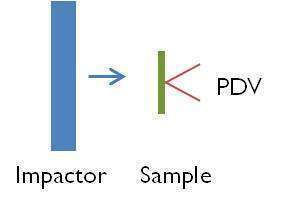Bulk metallic glasses (BMG) have recently garnered interest due to superior properties such as higher strength, toughness and hardness, arising out of the amorphous structure of these metallic alloys, as compared to their crystalline counterparts. They have potential for use across a broad spectrum of engineering applications, and therefore there is a need for them to be mechanically characterized over a large range of loading conditions. In this work, we study the high strain-rate response of two Fe-based BMGs, one fully amorphous and the other partially amorphous, when subjected to shock compression and dynamic tension. Shock response under compression and tension is determined by making velocity measurements using Photonic Doppler Velocimetry (PDV) at the rear free surface of BMG samples, which have been subjected to impact from a high-velocity projectile launched from a powder gun using the configuration shown in Figure 1.

Preliminary experiments yielded repeatable results of wave profiles containing a two-wave elastic-plastic structure and indicating a Hugoniot Elastic Limit (HEL) for the partially amorphous Fe-BMG to be 12.9 GPa. This is the highest observed HEL for any BMG thus far, and is more than one and half times the HEL values reported in the literature [1, 2]. Further results exploring response to shock compression will be presented. In addition, response to dynamic tension or spall, which will include microscopic examination of recovered samples in order to uncover damage mechanisms, will also be presented. The effect of partial crystallization in the amorphous matrix of BMG on the observed shock response will be ascertained through a comparison of the results from fully and partially amorphous samples.
References:
- S. J Turneaure, J. M Winey, Y. M Gupta, J. Appl. Phys. 2004, 84, 1692
- M. Martin, T. Sekine, T. Kobayashi, L. Kecskes, N. Thadani, Metall. Mater. Trans. 2007, 38A, 2689

